HR Report: M&S and HR Development of Individuals, Teams, Org
VerifiedAdded on 2020/07/22
|16
|4210
|83
Report
AI Summary
This report examines the crucial role of Human Resource Management in developing individuals, teams, and the overall organization, using Marks & Spencer as a case study. It explores the essential knowledge, skills, and behaviors required of HR professionals, emphasizing the importance of effective communication, innovation, and professional conduct. The report includes a personal skills audit and a professional development plan for a new HR officer, Jane Cambridge, highlighting the need for tailored training. It further analyzes the differences between individual and organizational learning, training, and development, and underscores the significance of continuous learning for sustainable business performance. Finally, it discusses high-performance working and performance management approaches to foster employee engagement and competitive advantage within the organizational context.
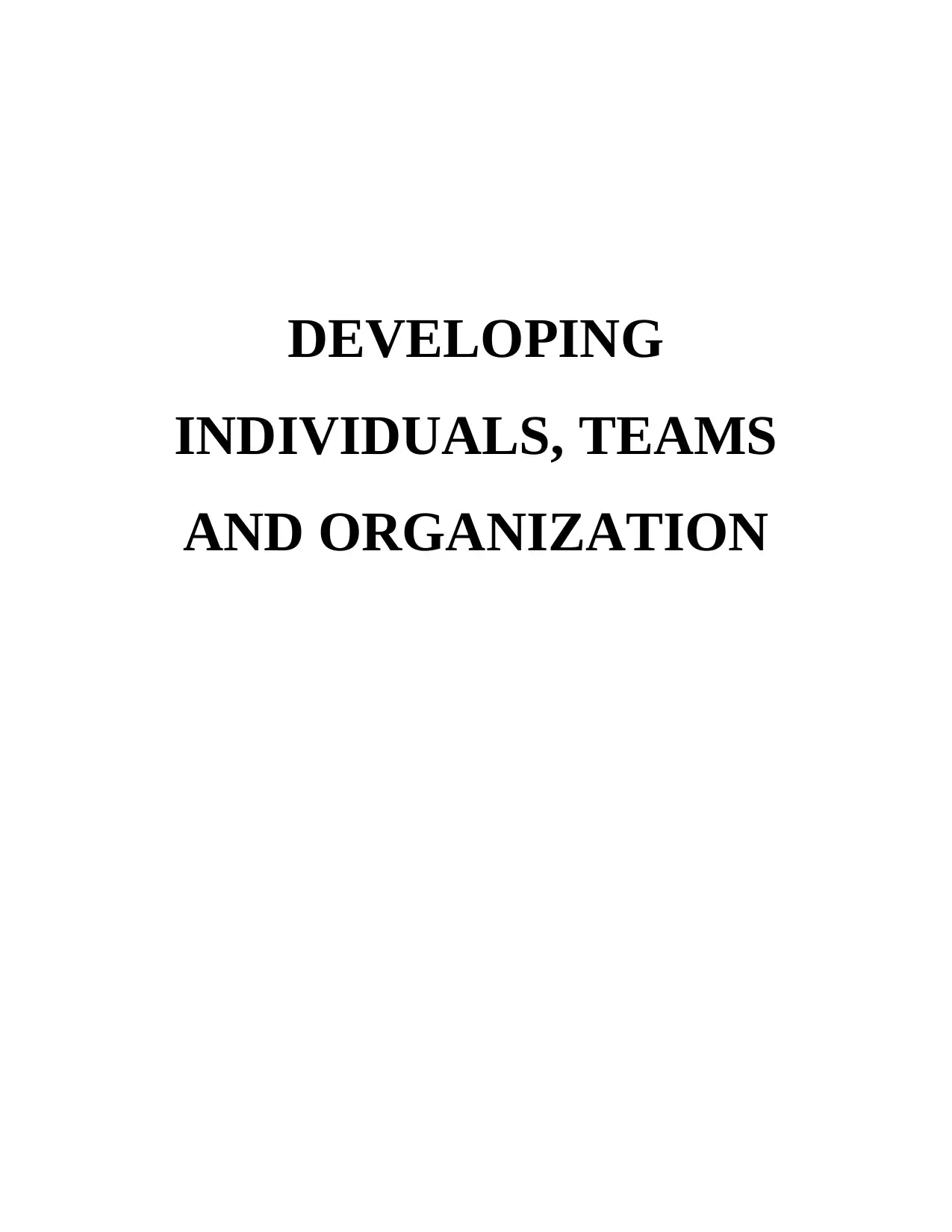
DEVELOPING
INDIVIDUALS, TEAMS
AND ORGANIZATION
INDIVIDUALS, TEAMS
AND ORGANIZATION
Paraphrase This Document
Need a fresh take? Get an instant paraphrase of this document with our AI Paraphraser

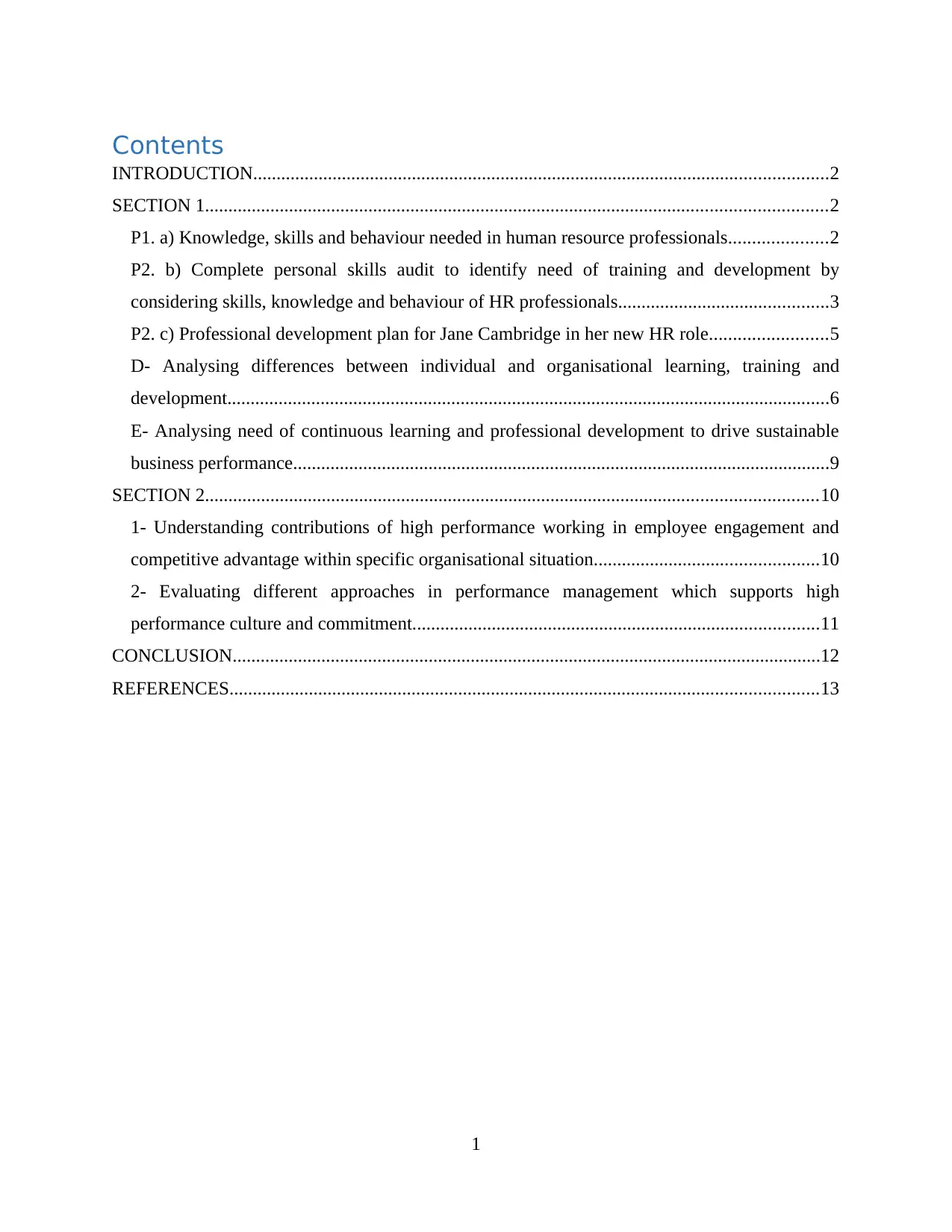
Contents
INTRODUCTION...........................................................................................................................2
SECTION 1.....................................................................................................................................2
P1. a) Knowledge, skills and behaviour needed in human resource professionals.....................2
P2. b) Complete personal skills audit to identify need of training and development by
considering skills, knowledge and behaviour of HR professionals.............................................3
P2. c) Professional development plan for Jane Cambridge in her new HR role.........................5
D- Analysing differences between individual and organisational learning, training and
development.................................................................................................................................6
E- Analysing need of continuous learning and professional development to drive sustainable
business performance...................................................................................................................9
SECTION 2...................................................................................................................................10
1- Understanding contributions of high performance working in employee engagement and
competitive advantage within specific organisational situation................................................10
2- Evaluating different approaches in performance management which supports high
performance culture and commitment.......................................................................................11
CONCLUSION..............................................................................................................................12
REFERENCES..............................................................................................................................13
1
INTRODUCTION...........................................................................................................................2
SECTION 1.....................................................................................................................................2
P1. a) Knowledge, skills and behaviour needed in human resource professionals.....................2
P2. b) Complete personal skills audit to identify need of training and development by
considering skills, knowledge and behaviour of HR professionals.............................................3
P2. c) Professional development plan for Jane Cambridge in her new HR role.........................5
D- Analysing differences between individual and organisational learning, training and
development.................................................................................................................................6
E- Analysing need of continuous learning and professional development to drive sustainable
business performance...................................................................................................................9
SECTION 2...................................................................................................................................10
1- Understanding contributions of high performance working in employee engagement and
competitive advantage within specific organisational situation................................................10
2- Evaluating different approaches in performance management which supports high
performance culture and commitment.......................................................................................11
CONCLUSION..............................................................................................................................12
REFERENCES..............................................................................................................................13
1
⊘ This is a preview!⊘
Do you want full access?
Subscribe today to unlock all pages.

Trusted by 1+ million students worldwide
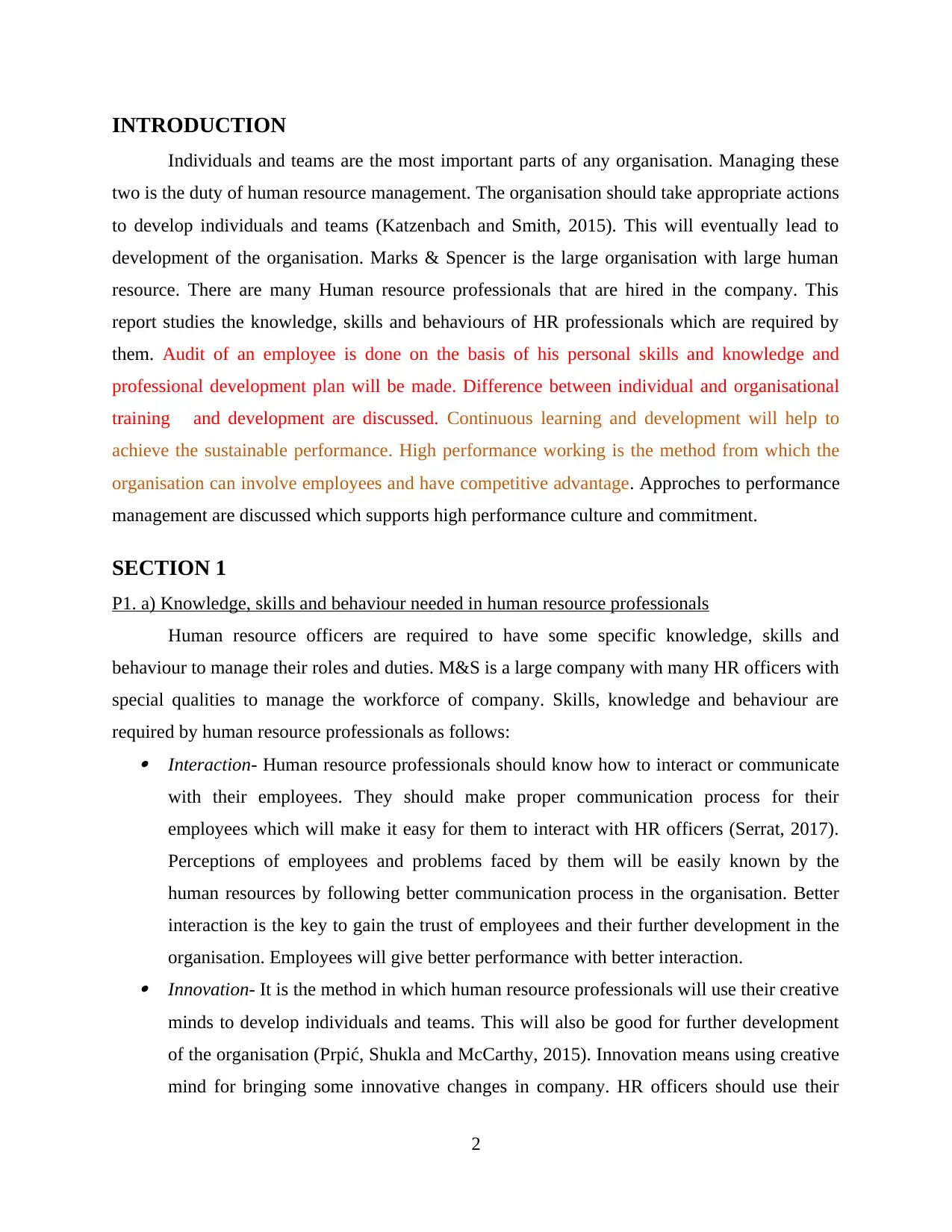
INTRODUCTION
Individuals and teams are the most important parts of any organisation. Managing these
two is the duty of human resource management. The organisation should take appropriate actions
to develop individuals and teams (Katzenbach and Smith, 2015). This will eventually lead to
development of the organisation. Marks & Spencer is the large organisation with large human
resource. There are many Human resource professionals that are hired in the company. This
report studies the knowledge, skills and behaviours of HR professionals which are required by
them. Audit of an employee is done on the basis of his personal skills and knowledge and
professional development plan will be made. Difference between individual and organisational
training and development are discussed. Continuous learning and development will help to
achieve the sustainable performance. High performance working is the method from which the
organisation can involve employees and have competitive advantage. Approches to performance
management are discussed which supports high performance culture and commitment.
SECTION 1
P1. a) Knowledge, skills and behaviour needed in human resource professionals
Human resource officers are required to have some specific knowledge, skills and
behaviour to manage their roles and duties. M&S is a large company with many HR officers with
special qualities to manage the workforce of company. Skills, knowledge and behaviour are
required by human resource professionals as follows: Interaction- Human resource professionals should know how to interact or communicate
with their employees. They should make proper communication process for their
employees which will make it easy for them to interact with HR officers (Serrat, 2017).
Perceptions of employees and problems faced by them will be easily known by the
human resources by following better communication process in the organisation. Better
interaction is the key to gain the trust of employees and their further development in the
organisation. Employees will give better performance with better interaction. Innovation- It is the method in which human resource professionals will use their creative
minds to develop individuals and teams. This will also be good for further development
of the organisation (Prpić, Shukla and McCarthy, 2015). Innovation means using creative
mind for bringing some innovative changes in company. HR officers should use their
2
Individuals and teams are the most important parts of any organisation. Managing these
two is the duty of human resource management. The organisation should take appropriate actions
to develop individuals and teams (Katzenbach and Smith, 2015). This will eventually lead to
development of the organisation. Marks & Spencer is the large organisation with large human
resource. There are many Human resource professionals that are hired in the company. This
report studies the knowledge, skills and behaviours of HR professionals which are required by
them. Audit of an employee is done on the basis of his personal skills and knowledge and
professional development plan will be made. Difference between individual and organisational
training and development are discussed. Continuous learning and development will help to
achieve the sustainable performance. High performance working is the method from which the
organisation can involve employees and have competitive advantage. Approches to performance
management are discussed which supports high performance culture and commitment.
SECTION 1
P1. a) Knowledge, skills and behaviour needed in human resource professionals
Human resource officers are required to have some specific knowledge, skills and
behaviour to manage their roles and duties. M&S is a large company with many HR officers with
special qualities to manage the workforce of company. Skills, knowledge and behaviour are
required by human resource professionals as follows: Interaction- Human resource professionals should know how to interact or communicate
with their employees. They should make proper communication process for their
employees which will make it easy for them to interact with HR officers (Serrat, 2017).
Perceptions of employees and problems faced by them will be easily known by the
human resources by following better communication process in the organisation. Better
interaction is the key to gain the trust of employees and their further development in the
organisation. Employees will give better performance with better interaction. Innovation- It is the method in which human resource professionals will use their creative
minds to develop individuals and teams. This will also be good for further development
of the organisation (Prpić, Shukla and McCarthy, 2015). Innovation means using creative
mind for bringing some innovative changes in company. HR officers should use their
2
Paraphrase This Document
Need a fresh take? Get an instant paraphrase of this document with our AI Paraphraser
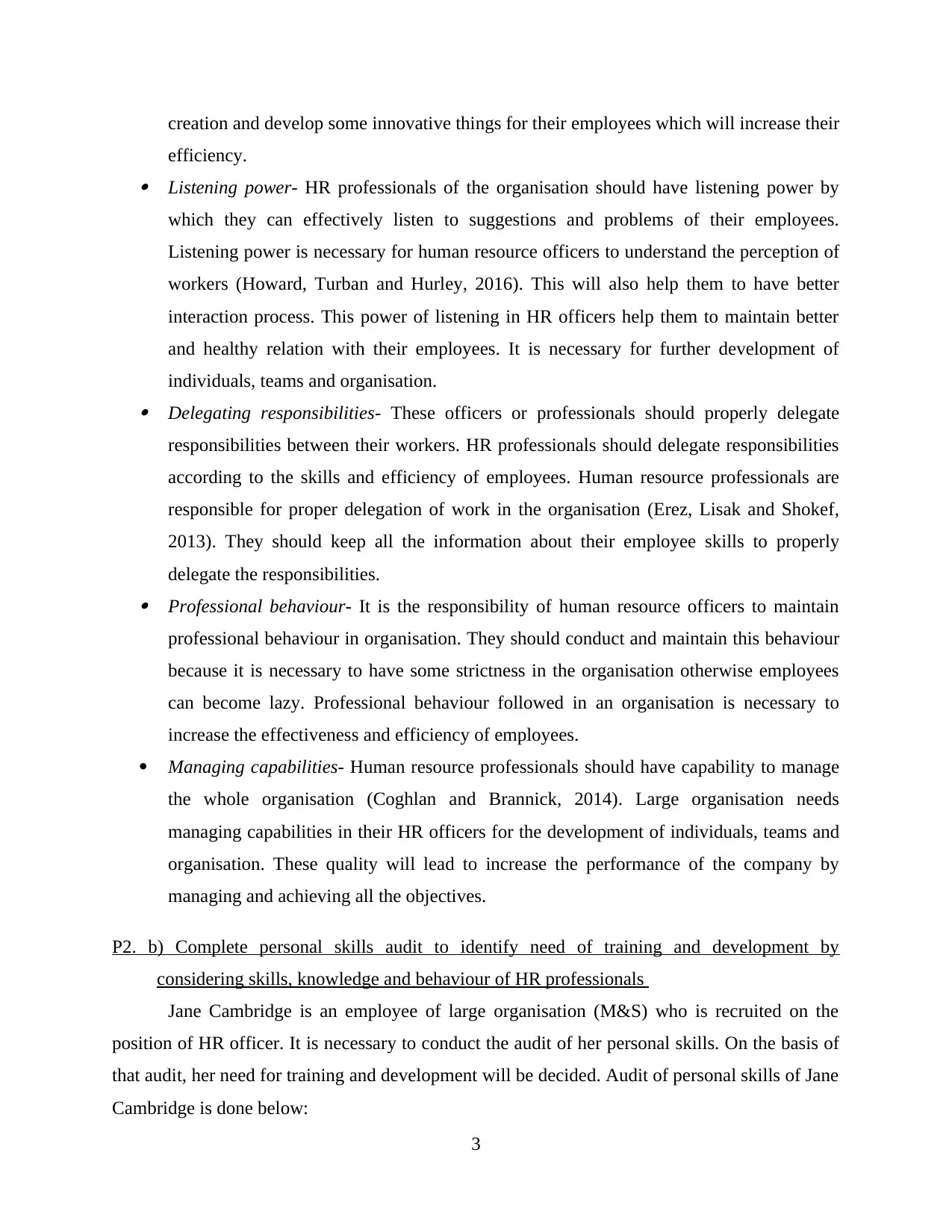
creation and develop some innovative things for their employees which will increase their
efficiency. Listening power- HR professionals of the organisation should have listening power by
which they can effectively listen to suggestions and problems of their employees.
Listening power is necessary for human resource officers to understand the perception of
workers (Howard, Turban and Hurley, 2016). This will also help them to have better
interaction process. This power of listening in HR officers help them to maintain better
and healthy relation with their employees. It is necessary for further development of
individuals, teams and organisation. Delegating responsibilities- These officers or professionals should properly delegate
responsibilities between their workers. HR professionals should delegate responsibilities
according to the skills and efficiency of employees. Human resource professionals are
responsible for proper delegation of work in the organisation (Erez, Lisak and Shokef,
2013). They should keep all the information about their employee skills to properly
delegate the responsibilities. Professional behaviour- It is the responsibility of human resource officers to maintain
professional behaviour in organisation. They should conduct and maintain this behaviour
because it is necessary to have some strictness in the organisation otherwise employees
can become lazy. Professional behaviour followed in an organisation is necessary to
increase the effectiveness and efficiency of employees.
Managing capabilities- Human resource professionals should have capability to manage
the whole organisation (Coghlan and Brannick, 2014). Large organisation needs
managing capabilities in their HR officers for the development of individuals, teams and
organisation. These quality will lead to increase the performance of the company by
managing and achieving all the objectives.
P2. b) Complete personal skills audit to identify need of training and development by
considering skills, knowledge and behaviour of HR professionals
Jane Cambridge is an employee of large organisation (M&S) who is recruited on the
position of HR officer. It is necessary to conduct the audit of her personal skills. On the basis of
that audit, her need for training and development will be decided. Audit of personal skills of Jane
Cambridge is done below:
3
efficiency. Listening power- HR professionals of the organisation should have listening power by
which they can effectively listen to suggestions and problems of their employees.
Listening power is necessary for human resource officers to understand the perception of
workers (Howard, Turban and Hurley, 2016). This will also help them to have better
interaction process. This power of listening in HR officers help them to maintain better
and healthy relation with their employees. It is necessary for further development of
individuals, teams and organisation. Delegating responsibilities- These officers or professionals should properly delegate
responsibilities between their workers. HR professionals should delegate responsibilities
according to the skills and efficiency of employees. Human resource professionals are
responsible for proper delegation of work in the organisation (Erez, Lisak and Shokef,
2013). They should keep all the information about their employee skills to properly
delegate the responsibilities. Professional behaviour- It is the responsibility of human resource officers to maintain
professional behaviour in organisation. They should conduct and maintain this behaviour
because it is necessary to have some strictness in the organisation otherwise employees
can become lazy. Professional behaviour followed in an organisation is necessary to
increase the effectiveness and efficiency of employees.
Managing capabilities- Human resource professionals should have capability to manage
the whole organisation (Coghlan and Brannick, 2014). Large organisation needs
managing capabilities in their HR officers for the development of individuals, teams and
organisation. These quality will lead to increase the performance of the company by
managing and achieving all the objectives.
P2. b) Complete personal skills audit to identify need of training and development by
considering skills, knowledge and behaviour of HR professionals
Jane Cambridge is an employee of large organisation (M&S) who is recruited on the
position of HR officer. It is necessary to conduct the audit of her personal skills. On the basis of
that audit, her need for training and development will be decided. Audit of personal skills of Jane
Cambridge is done below:
3
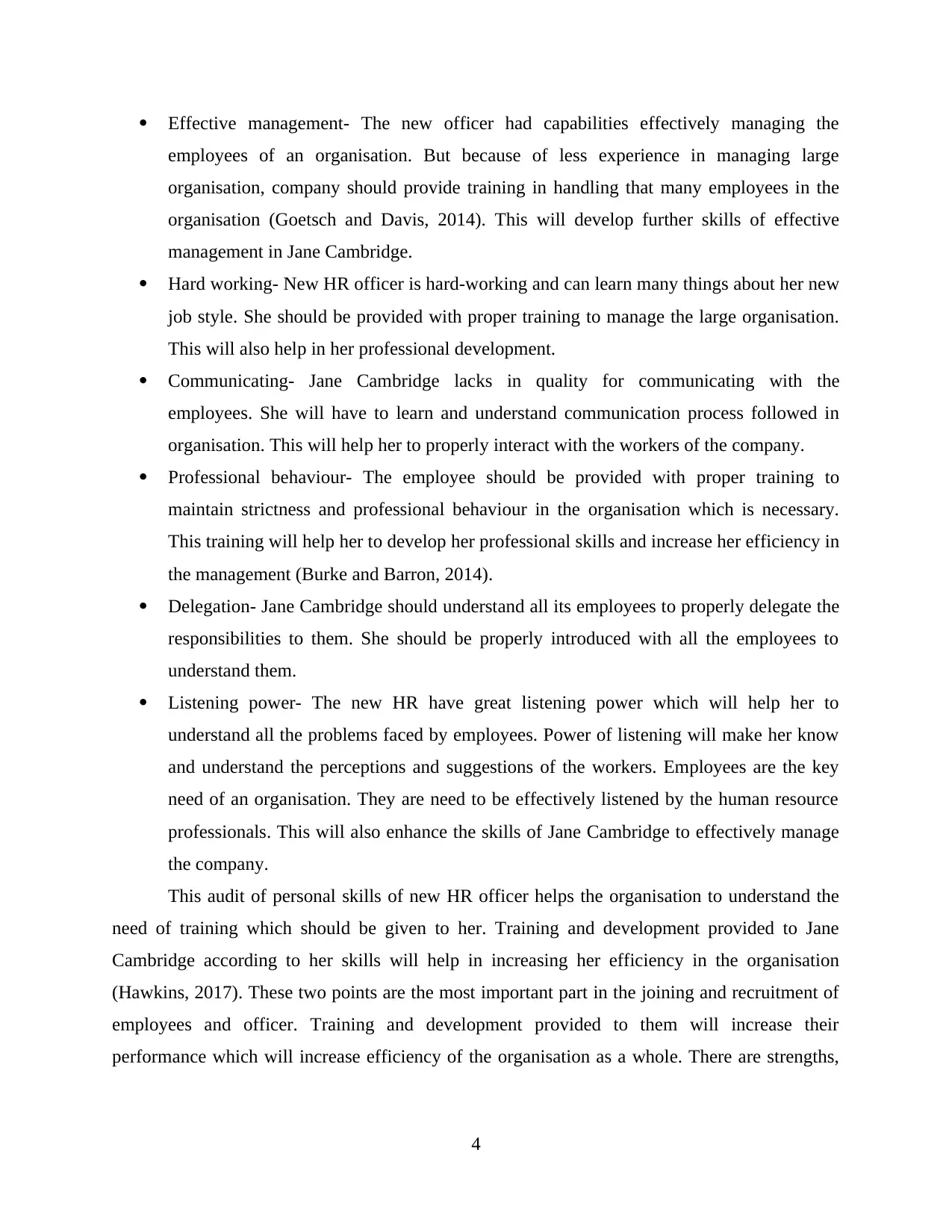
Effective management- The new officer had capabilities effectively managing the
employees of an organisation. But because of less experience in managing large
organisation, company should provide training in handling that many employees in the
organisation (Goetsch and Davis, 2014). This will develop further skills of effective
management in Jane Cambridge.
Hard working- New HR officer is hard-working and can learn many things about her new
job style. She should be provided with proper training to manage the large organisation.
This will also help in her professional development.
Communicating- Jane Cambridge lacks in quality for communicating with the
employees. She will have to learn and understand communication process followed in
organisation. This will help her to properly interact with the workers of the company.
Professional behaviour- The employee should be provided with proper training to
maintain strictness and professional behaviour in the organisation which is necessary.
This training will help her to develop her professional skills and increase her efficiency in
the management (Burke and Barron, 2014).
Delegation- Jane Cambridge should understand all its employees to properly delegate the
responsibilities to them. She should be properly introduced with all the employees to
understand them.
Listening power- The new HR have great listening power which will help her to
understand all the problems faced by employees. Power of listening will make her know
and understand the perceptions and suggestions of the workers. Employees are the key
need of an organisation. They are need to be effectively listened by the human resource
professionals. This will also enhance the skills of Jane Cambridge to effectively manage
the company.
This audit of personal skills of new HR officer helps the organisation to understand the
need of training which should be given to her. Training and development provided to Jane
Cambridge according to her skills will help in increasing her efficiency in the organisation
(Hawkins, 2017). These two points are the most important part in the joining and recruitment of
employees and officer. Training and development provided to them will increase their
performance which will increase efficiency of the organisation as a whole. There are strengths,
4
employees of an organisation. But because of less experience in managing large
organisation, company should provide training in handling that many employees in the
organisation (Goetsch and Davis, 2014). This will develop further skills of effective
management in Jane Cambridge.
Hard working- New HR officer is hard-working and can learn many things about her new
job style. She should be provided with proper training to manage the large organisation.
This will also help in her professional development.
Communicating- Jane Cambridge lacks in quality for communicating with the
employees. She will have to learn and understand communication process followed in
organisation. This will help her to properly interact with the workers of the company.
Professional behaviour- The employee should be provided with proper training to
maintain strictness and professional behaviour in the organisation which is necessary.
This training will help her to develop her professional skills and increase her efficiency in
the management (Burke and Barron, 2014).
Delegation- Jane Cambridge should understand all its employees to properly delegate the
responsibilities to them. She should be properly introduced with all the employees to
understand them.
Listening power- The new HR have great listening power which will help her to
understand all the problems faced by employees. Power of listening will make her know
and understand the perceptions and suggestions of the workers. Employees are the key
need of an organisation. They are need to be effectively listened by the human resource
professionals. This will also enhance the skills of Jane Cambridge to effectively manage
the company.
This audit of personal skills of new HR officer helps the organisation to understand the
need of training which should be given to her. Training and development provided to Jane
Cambridge according to her skills will help in increasing her efficiency in the organisation
(Hawkins, 2017). These two points are the most important part in the joining and recruitment of
employees and officer. Training and development provided to them will increase their
performance which will increase efficiency of the organisation as a whole. There are strengths,
4
⊘ This is a preview!⊘
Do you want full access?
Subscribe today to unlock all pages.

Trusted by 1+ million students worldwide
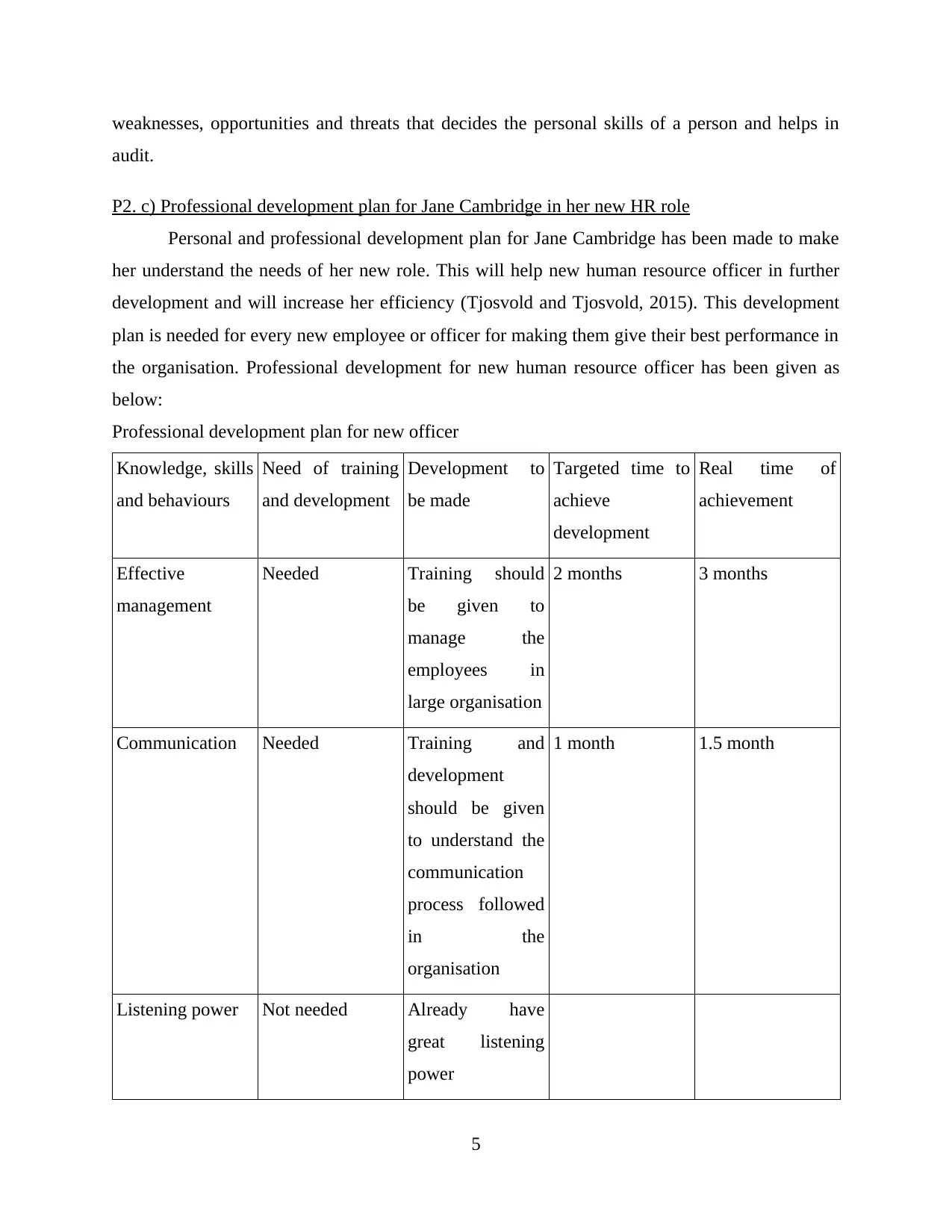
weaknesses, opportunities and threats that decides the personal skills of a person and helps in
audit.
P2. c) Professional development plan for Jane Cambridge in her new HR role
Personal and professional development plan for Jane Cambridge has been made to make
her understand the needs of her new role. This will help new human resource officer in further
development and will increase her efficiency (Tjosvold and Tjosvold, 2015). This development
plan is needed for every new employee or officer for making them give their best performance in
the organisation. Professional development for new human resource officer has been given as
below:
Professional development plan for new officer
Knowledge, skills
and behaviours
Need of training
and development
Development to
be made
Targeted time to
achieve
development
Real time of
achievement
Effective
management
Needed Training should
be given to
manage the
employees in
large organisation
2 months 3 months
Communication Needed Training and
development
should be given
to understand the
communication
process followed
in the
organisation
1 month 1.5 month
Listening power Not needed Already have
great listening
power
5
audit.
P2. c) Professional development plan for Jane Cambridge in her new HR role
Personal and professional development plan for Jane Cambridge has been made to make
her understand the needs of her new role. This will help new human resource officer in further
development and will increase her efficiency (Tjosvold and Tjosvold, 2015). This development
plan is needed for every new employee or officer for making them give their best performance in
the organisation. Professional development for new human resource officer has been given as
below:
Professional development plan for new officer
Knowledge, skills
and behaviours
Need of training
and development
Development to
be made
Targeted time to
achieve
development
Real time of
achievement
Effective
management
Needed Training should
be given to
manage the
employees in
large organisation
2 months 3 months
Communication Needed Training and
development
should be given
to understand the
communication
process followed
in the
organisation
1 month 1.5 month
Listening power Not needed Already have
great listening
power
5
Paraphrase This Document
Need a fresh take? Get an instant paraphrase of this document with our AI Paraphraser
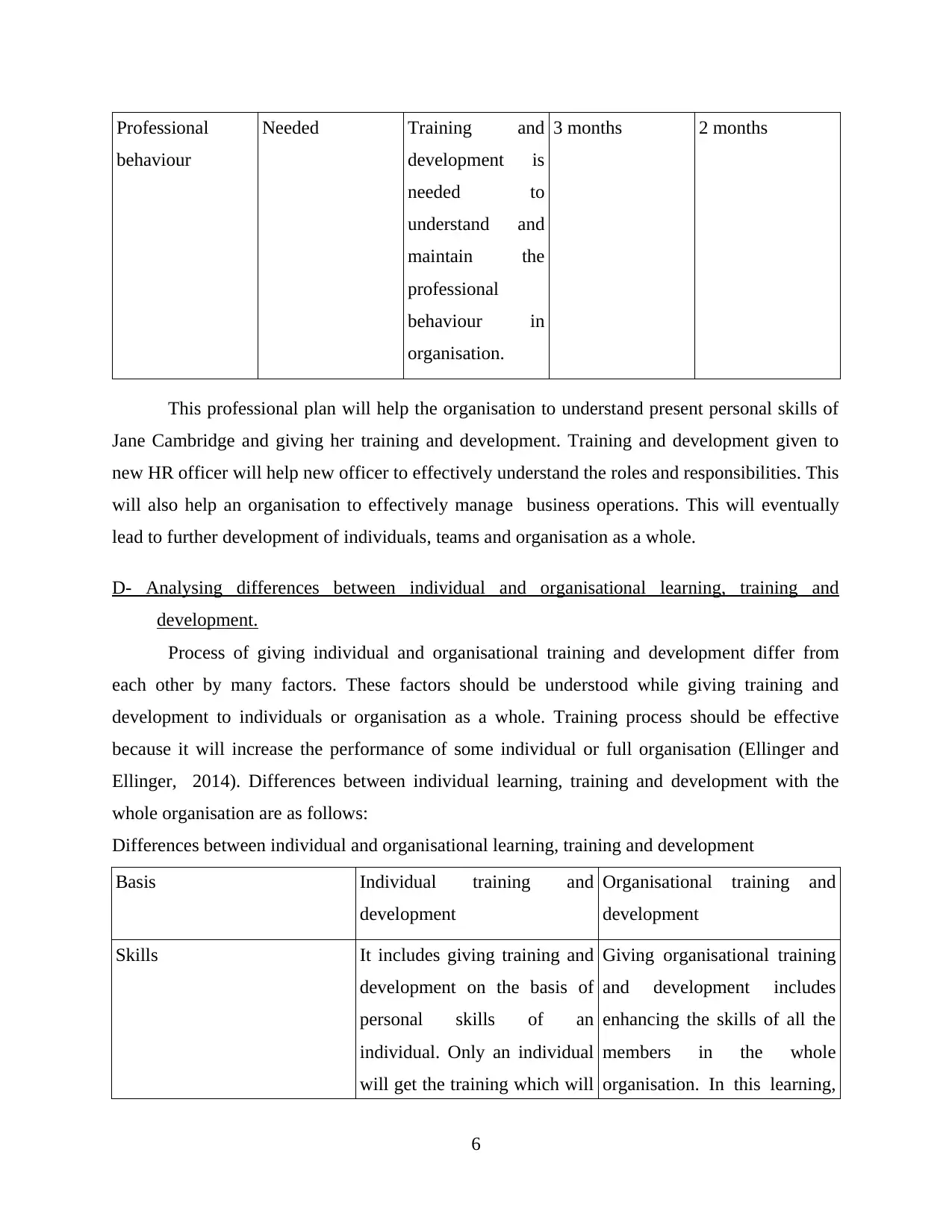
Professional
behaviour
Needed Training and
development is
needed to
understand and
maintain the
professional
behaviour in
organisation.
3 months 2 months
This professional plan will help the organisation to understand present personal skills of
Jane Cambridge and giving her training and development. Training and development given to
new HR officer will help new officer to effectively understand the roles and responsibilities. This
will also help an organisation to effectively manage business operations. This will eventually
lead to further development of individuals, teams and organisation as a whole.
D- Analysing differences between individual and organisational learning, training and
development.
Process of giving individual and organisational training and development differ from
each other by many factors. These factors should be understood while giving training and
development to individuals or organisation as a whole. Training process should be effective
because it will increase the performance of some individual or full organisation (Ellinger and
Ellinger, 2014). Differences between individual learning, training and development with the
whole organisation are as follows:
Differences between individual and organisational learning, training and development
Basis Individual training and
development
Organisational training and
development
Skills It includes giving training and
development on the basis of
personal skills of an
individual. Only an individual
will get the training which will
Giving organisational training
and development includes
enhancing the skills of all the
members in the whole
organisation. In this learning,
6
behaviour
Needed Training and
development is
needed to
understand and
maintain the
professional
behaviour in
organisation.
3 months 2 months
This professional plan will help the organisation to understand present personal skills of
Jane Cambridge and giving her training and development. Training and development given to
new HR officer will help new officer to effectively understand the roles and responsibilities. This
will also help an organisation to effectively manage business operations. This will eventually
lead to further development of individuals, teams and organisation as a whole.
D- Analysing differences between individual and organisational learning, training and
development.
Process of giving individual and organisational training and development differ from
each other by many factors. These factors should be understood while giving training and
development to individuals or organisation as a whole. Training process should be effective
because it will increase the performance of some individual or full organisation (Ellinger and
Ellinger, 2014). Differences between individual learning, training and development with the
whole organisation are as follows:
Differences between individual and organisational learning, training and development
Basis Individual training and
development
Organisational training and
development
Skills It includes giving training and
development on the basis of
personal skills of an
individual. Only an individual
will get the training which will
Giving organisational training
and development includes
enhancing the skills of all the
members in the whole
organisation. In this learning,
6
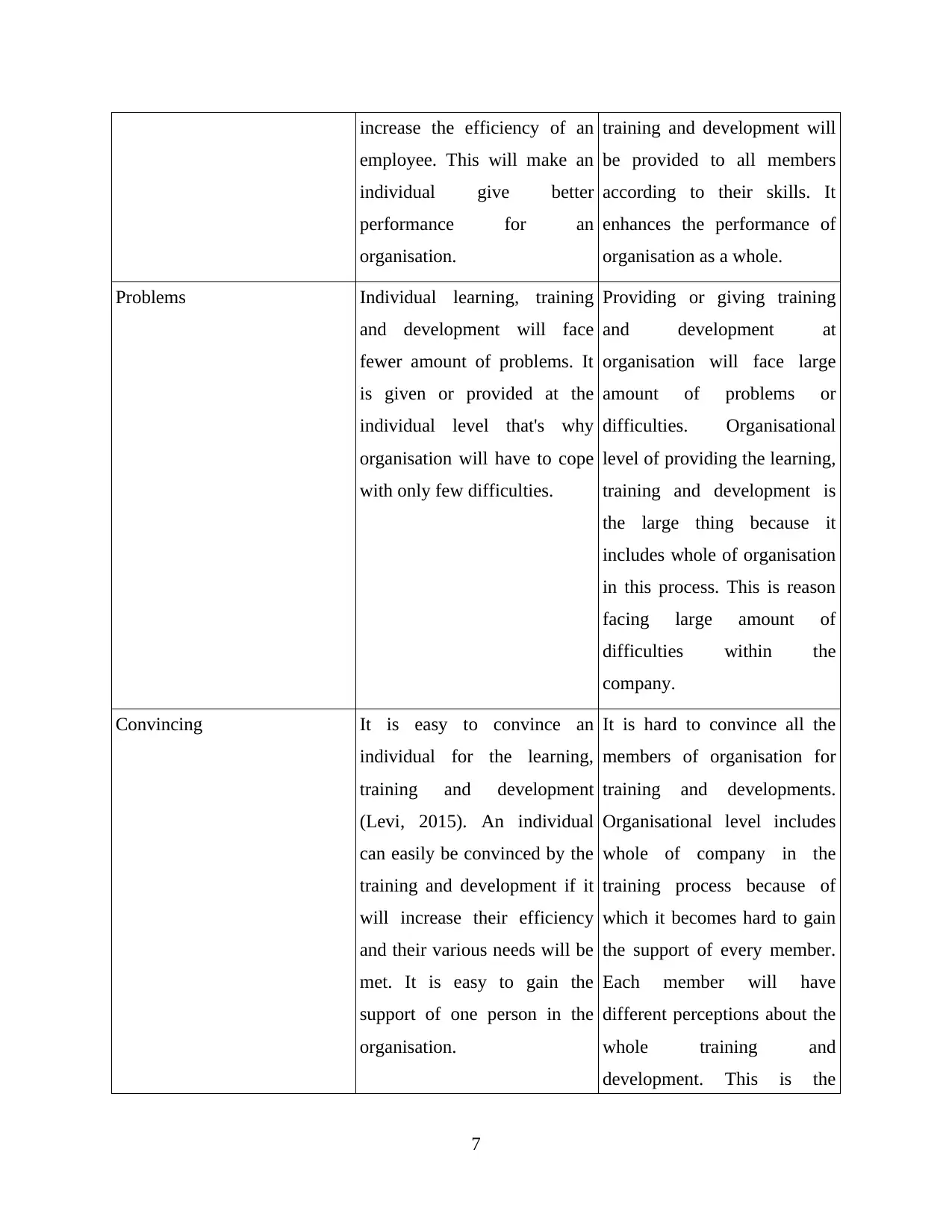
increase the efficiency of an
employee. This will make an
individual give better
performance for an
organisation.
training and development will
be provided to all members
according to their skills. It
enhances the performance of
organisation as a whole.
Problems Individual learning, training
and development will face
fewer amount of problems. It
is given or provided at the
individual level that's why
organisation will have to cope
with only few difficulties.
Providing or giving training
and development at
organisation will face large
amount of problems or
difficulties. Organisational
level of providing the learning,
training and development is
the large thing because it
includes whole of organisation
in this process. This is reason
facing large amount of
difficulties within the
company.
Convincing It is easy to convince an
individual for the learning,
training and development
(Levi, 2015). An individual
can easily be convinced by the
training and development if it
will increase their efficiency
and their various needs will be
met. It is easy to gain the
support of one person in the
organisation.
It is hard to convince all the
members of organisation for
training and developments.
Organisational level includes
whole of company in the
training process because of
which it becomes hard to gain
the support of every member.
Each member will have
different perceptions about the
whole training and
development. This is the
7
employee. This will make an
individual give better
performance for an
organisation.
training and development will
be provided to all members
according to their skills. It
enhances the performance of
organisation as a whole.
Problems Individual learning, training
and development will face
fewer amount of problems. It
is given or provided at the
individual level that's why
organisation will have to cope
with only few difficulties.
Providing or giving training
and development at
organisation will face large
amount of problems or
difficulties. Organisational
level of providing the learning,
training and development is
the large thing because it
includes whole of organisation
in this process. This is reason
facing large amount of
difficulties within the
company.
Convincing It is easy to convince an
individual for the learning,
training and development
(Levi, 2015). An individual
can easily be convinced by the
training and development if it
will increase their efficiency
and their various needs will be
met. It is easy to gain the
support of one person in the
organisation.
It is hard to convince all the
members of organisation for
training and developments.
Organisational level includes
whole of company in the
training process because of
which it becomes hard to gain
the support of every member.
Each member will have
different perceptions about the
whole training and
development. This is the
7
⊘ This is a preview!⊘
Do you want full access?
Subscribe today to unlock all pages.

Trusted by 1+ million students worldwide
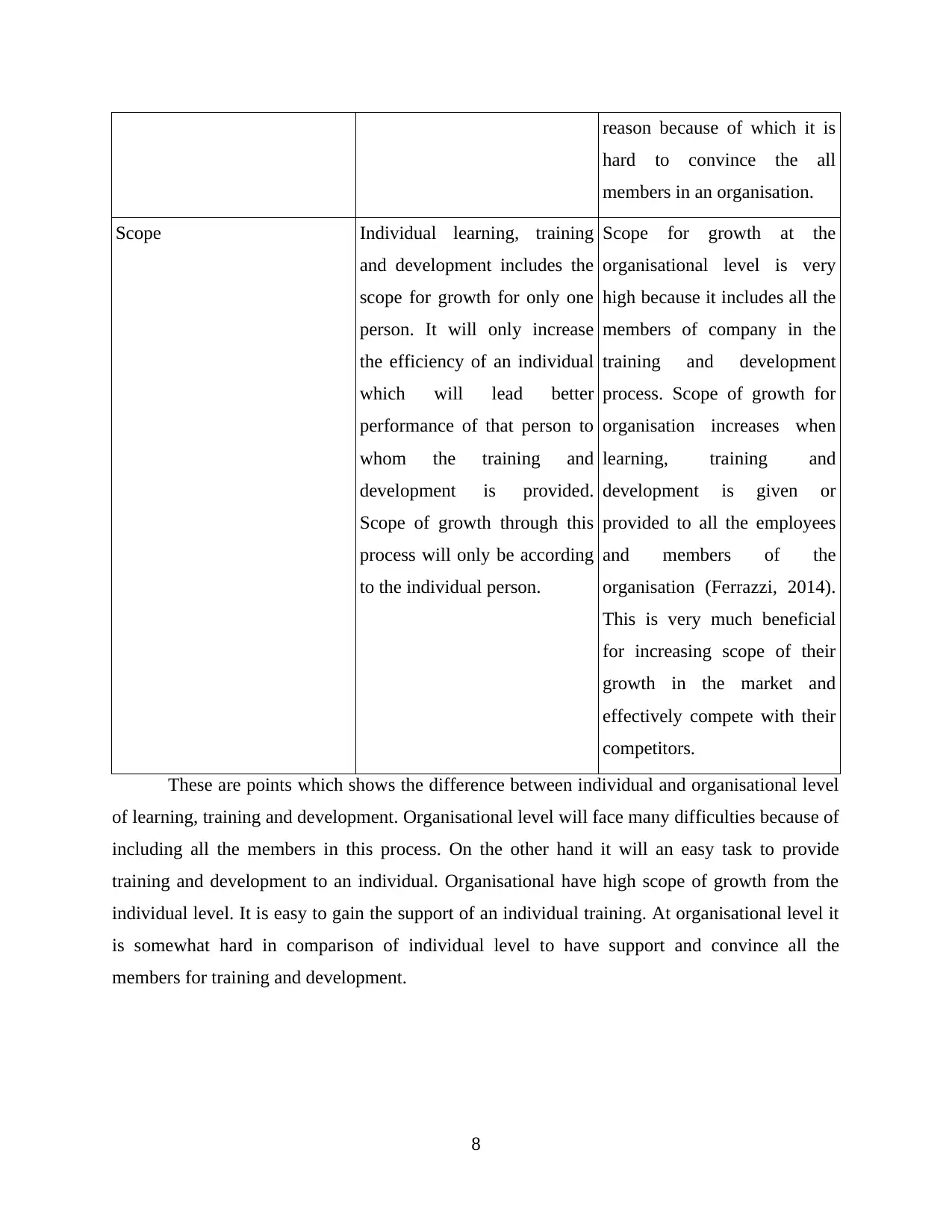
reason because of which it is
hard to convince the all
members in an organisation.
Scope Individual learning, training
and development includes the
scope for growth for only one
person. It will only increase
the efficiency of an individual
which will lead better
performance of that person to
whom the training and
development is provided.
Scope of growth through this
process will only be according
to the individual person.
Scope for growth at the
organisational level is very
high because it includes all the
members of company in the
training and development
process. Scope of growth for
organisation increases when
learning, training and
development is given or
provided to all the employees
and members of the
organisation (Ferrazzi, 2014).
This is very much beneficial
for increasing scope of their
growth in the market and
effectively compete with their
competitors.
These are points which shows the difference between individual and organisational level
of learning, training and development. Organisational level will face many difficulties because of
including all the members in this process. On the other hand it will an easy task to provide
training and development to an individual. Organisational have high scope of growth from the
individual level. It is easy to gain the support of an individual training. At organisational level it
is somewhat hard in comparison of individual level to have support and convince all the
members for training and development.
8
hard to convince the all
members in an organisation.
Scope Individual learning, training
and development includes the
scope for growth for only one
person. It will only increase
the efficiency of an individual
which will lead better
performance of that person to
whom the training and
development is provided.
Scope of growth through this
process will only be according
to the individual person.
Scope for growth at the
organisational level is very
high because it includes all the
members of company in the
training and development
process. Scope of growth for
organisation increases when
learning, training and
development is given or
provided to all the employees
and members of the
organisation (Ferrazzi, 2014).
This is very much beneficial
for increasing scope of their
growth in the market and
effectively compete with their
competitors.
These are points which shows the difference between individual and organisational level
of learning, training and development. Organisational level will face many difficulties because of
including all the members in this process. On the other hand it will an easy task to provide
training and development to an individual. Organisational have high scope of growth from the
individual level. It is easy to gain the support of an individual training. At organisational level it
is somewhat hard in comparison of individual level to have support and convince all the
members for training and development.
8
Paraphrase This Document
Need a fresh take? Get an instant paraphrase of this document with our AI Paraphraser
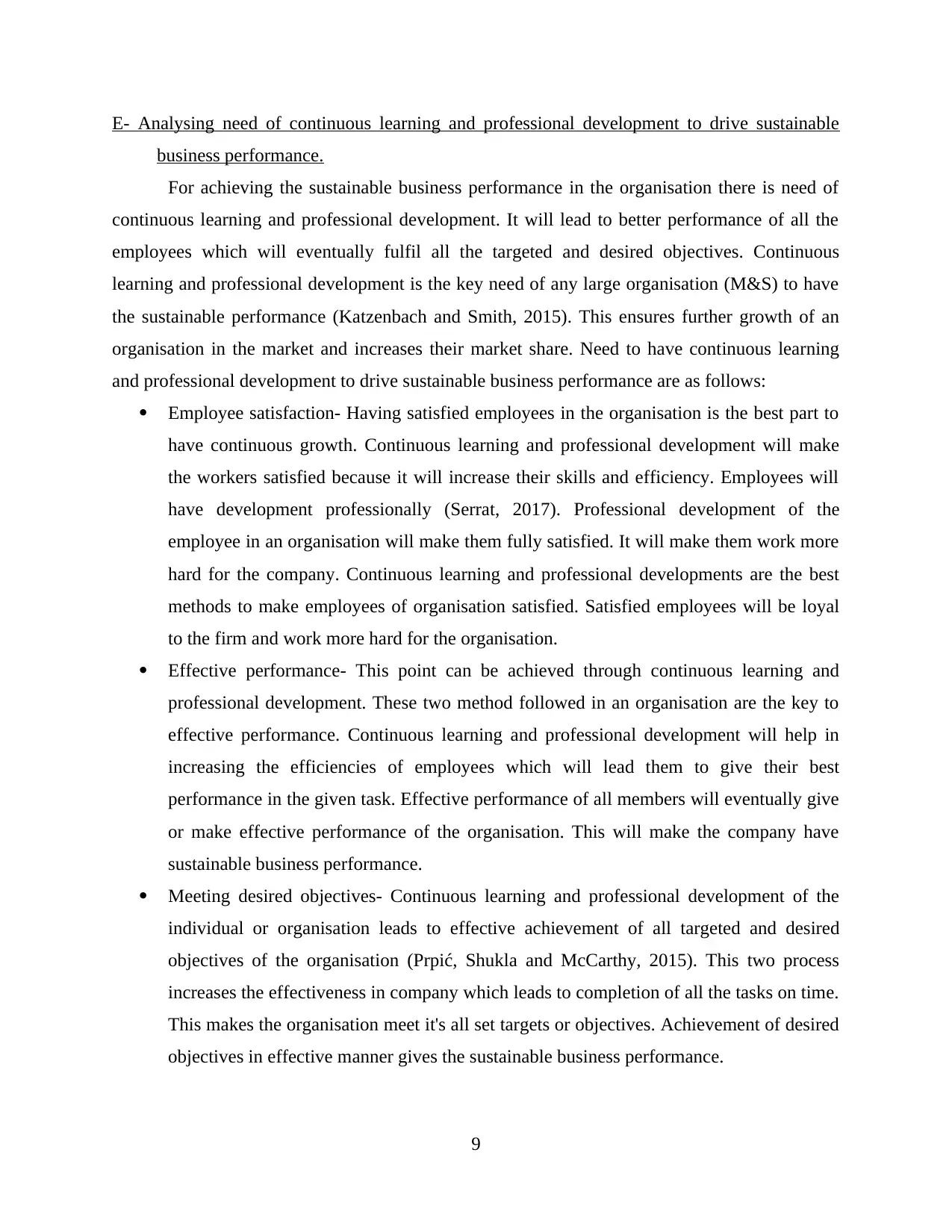
E- Analysing need of continuous learning and professional development to drive sustainable
business performance.
For achieving the sustainable business performance in the organisation there is need of
continuous learning and professional development. It will lead to better performance of all the
employees which will eventually fulfil all the targeted and desired objectives. Continuous
learning and professional development is the key need of any large organisation (M&S) to have
the sustainable performance (Katzenbach and Smith, 2015). This ensures further growth of an
organisation in the market and increases their market share. Need to have continuous learning
and professional development to drive sustainable business performance are as follows:
Employee satisfaction- Having satisfied employees in the organisation is the best part to
have continuous growth. Continuous learning and professional development will make
the workers satisfied because it will increase their skills and efficiency. Employees will
have development professionally (Serrat, 2017). Professional development of the
employee in an organisation will make them fully satisfied. It will make them work more
hard for the company. Continuous learning and professional developments are the best
methods to make employees of organisation satisfied. Satisfied employees will be loyal
to the firm and work more hard for the organisation.
Effective performance- This point can be achieved through continuous learning and
professional development. These two method followed in an organisation are the key to
effective performance. Continuous learning and professional development will help in
increasing the efficiencies of employees which will lead them to give their best
performance in the given task. Effective performance of all members will eventually give
or make effective performance of the organisation. This will make the company have
sustainable business performance.
Meeting desired objectives- Continuous learning and professional development of the
individual or organisation leads to effective achievement of all targeted and desired
objectives of the organisation (Prpić, Shukla and McCarthy, 2015). This two process
increases the effectiveness in company which leads to completion of all the tasks on time.
This makes the organisation meet it's all set targets or objectives. Achievement of desired
objectives in effective manner gives the sustainable business performance.
9
business performance.
For achieving the sustainable business performance in the organisation there is need of
continuous learning and professional development. It will lead to better performance of all the
employees which will eventually fulfil all the targeted and desired objectives. Continuous
learning and professional development is the key need of any large organisation (M&S) to have
the sustainable performance (Katzenbach and Smith, 2015). This ensures further growth of an
organisation in the market and increases their market share. Need to have continuous learning
and professional development to drive sustainable business performance are as follows:
Employee satisfaction- Having satisfied employees in the organisation is the best part to
have continuous growth. Continuous learning and professional development will make
the workers satisfied because it will increase their skills and efficiency. Employees will
have development professionally (Serrat, 2017). Professional development of the
employee in an organisation will make them fully satisfied. It will make them work more
hard for the company. Continuous learning and professional developments are the best
methods to make employees of organisation satisfied. Satisfied employees will be loyal
to the firm and work more hard for the organisation.
Effective performance- This point can be achieved through continuous learning and
professional development. These two method followed in an organisation are the key to
effective performance. Continuous learning and professional development will help in
increasing the efficiencies of employees which will lead them to give their best
performance in the given task. Effective performance of all members will eventually give
or make effective performance of the organisation. This will make the company have
sustainable business performance.
Meeting desired objectives- Continuous learning and professional development of the
individual or organisation leads to effective achievement of all targeted and desired
objectives of the organisation (Prpić, Shukla and McCarthy, 2015). This two process
increases the effectiveness in company which leads to completion of all the tasks on time.
This makes the organisation meet it's all set targets or objectives. Achievement of desired
objectives in effective manner gives the sustainable business performance.
9
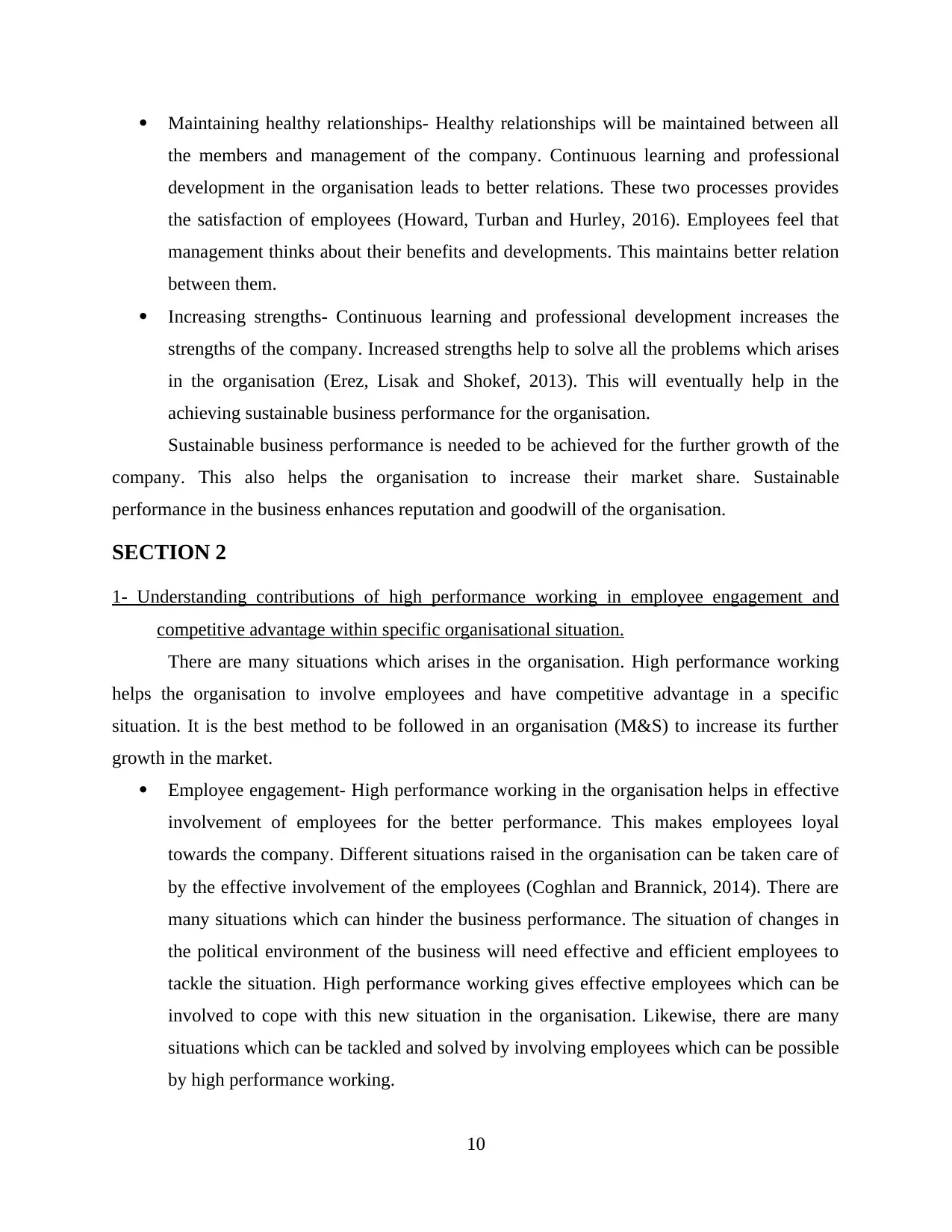
Maintaining healthy relationships- Healthy relationships will be maintained between all
the members and management of the company. Continuous learning and professional
development in the organisation leads to better relations. These two processes provides
the satisfaction of employees (Howard, Turban and Hurley, 2016). Employees feel that
management thinks about their benefits and developments. This maintains better relation
between them.
Increasing strengths- Continuous learning and professional development increases the
strengths of the company. Increased strengths help to solve all the problems which arises
in the organisation (Erez, Lisak and Shokef, 2013). This will eventually help in the
achieving sustainable business performance for the organisation.
Sustainable business performance is needed to be achieved for the further growth of the
company. This also helps the organisation to increase their market share. Sustainable
performance in the business enhances reputation and goodwill of the organisation.
SECTION 2
1- Understanding contributions of high performance working in employee engagement and
competitive advantage within specific organisational situation.
There are many situations which arises in the organisation. High performance working
helps the organisation to involve employees and have competitive advantage in a specific
situation. It is the best method to be followed in an organisation (M&S) to increase its further
growth in the market.
Employee engagement- High performance working in the organisation helps in effective
involvement of employees for the better performance. This makes employees loyal
towards the company. Different situations raised in the organisation can be taken care of
by the effective involvement of the employees (Coghlan and Brannick, 2014). There are
many situations which can hinder the business performance. The situation of changes in
the political environment of the business will need effective and efficient employees to
tackle the situation. High performance working gives effective employees which can be
involved to cope with this new situation in the organisation. Likewise, there are many
situations which can be tackled and solved by involving employees which can be possible
by high performance working.
10
the members and management of the company. Continuous learning and professional
development in the organisation leads to better relations. These two processes provides
the satisfaction of employees (Howard, Turban and Hurley, 2016). Employees feel that
management thinks about their benefits and developments. This maintains better relation
between them.
Increasing strengths- Continuous learning and professional development increases the
strengths of the company. Increased strengths help to solve all the problems which arises
in the organisation (Erez, Lisak and Shokef, 2013). This will eventually help in the
achieving sustainable business performance for the organisation.
Sustainable business performance is needed to be achieved for the further growth of the
company. This also helps the organisation to increase their market share. Sustainable
performance in the business enhances reputation and goodwill of the organisation.
SECTION 2
1- Understanding contributions of high performance working in employee engagement and
competitive advantage within specific organisational situation.
There are many situations which arises in the organisation. High performance working
helps the organisation to involve employees and have competitive advantage in a specific
situation. It is the best method to be followed in an organisation (M&S) to increase its further
growth in the market.
Employee engagement- High performance working in the organisation helps in effective
involvement of employees for the better performance. This makes employees loyal
towards the company. Different situations raised in the organisation can be taken care of
by the effective involvement of the employees (Coghlan and Brannick, 2014). There are
many situations which can hinder the business performance. The situation of changes in
the political environment of the business will need effective and efficient employees to
tackle the situation. High performance working gives effective employees which can be
involved to cope with this new situation in the organisation. Likewise, there are many
situations which can be tackled and solved by involving employees which can be possible
by high performance working.
10
⊘ This is a preview!⊘
Do you want full access?
Subscribe today to unlock all pages.

Trusted by 1+ million students worldwide
1 out of 16
Related Documents
Your All-in-One AI-Powered Toolkit for Academic Success.
+13062052269
info@desklib.com
Available 24*7 on WhatsApp / Email
![[object Object]](/_next/static/media/star-bottom.7253800d.svg)
Unlock your academic potential
Copyright © 2020–2025 A2Z Services. All Rights Reserved. Developed and managed by ZUCOL.





